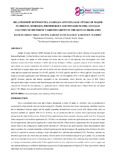Relationship between tea (camellia sinensis) leaf uptake of major nutrients, Nitrogen, Phosphorous and Potassium (NPK) and leaf anatomy of different varieties grown in the Kenyan highlands

View/
Date
2014Author
Njogu, Rachel N
Kariuki, David K
Kamau, David N
Wachira, Francis N
Language
enMetadata
Show full item recordAbstract
Uptake of major nutrients (NPK) through the leaf st
udies were carried out on three varieties of tea gr
own in the
Kenyan Highlands. A foliar fertilizers trial was se
tup in three sites comprising of 36 plots per site
in the major tea growing
regions in Kenya. The uptake of NPK through leaf ti
ssue and the role of leaf anatomy were investigated
. Two foliar
fertilizers tested were Foliar Fertilizer 1 (FF1) a
nd Foliar Fertilizer 2 (FF2), a positive control of
Soil Fertilizer (SF)
and a blank were used to standardize the method. Le
af anatomical studies were done by determining the
stomata count of
the third leaf of sample plants from each plot in a
ll the trial sites. Results showed significant corr
elation between stomata
count and first mature leaf nutrients; N (r=0.387,
p
≤
0.05), P (r=0.32, p
≤
0.01) and K% (r=-0.014, p
≤
0.01). Tea yields were
found to correlate significantly with NPK nutrient
uptake; N% r=0.453 (p
≤
0.01), P% r=-0.332, p
≤
0.01 and K% r=-0.373,
p
≤
0.05. Stomatal patterns and density responded to th
e environment, where Kericho site (west of Rift Val
ley)
had significantly higher stomata count than Kirinya
ga and Meru sites both in east of Rift valley at HS
D= 6.5, 5.6 at p
≤
0.05
respectively. Overall the
leaf anatomy, i.e. epidermal layers (<50μm thick),
palisade layers (50μm thick) and mesophyll
layers (150-200μm) were not affected by fertilizer
application
Citation
BEST: International Journal of Humanities, Arts, Medicine and Sciences (BEST: IJHAMS) ISSN 2348-0521 Vol. 2, Issue 8, Aug 2014, 95-102Publisher
University of Nairobi
